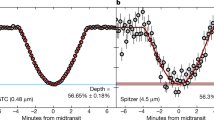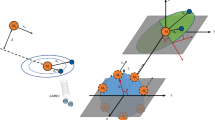Abstract
HARRISON1 has recently hypothesised that the Sun possesses a companion star, in order to explain an anomaly in the distribution on the sky of pulsars which lose speed very slowly. This is a controversial suggestion mainly because proper motion sky surveys down to at least 14th mag (ref. 2) should have detected such an object. However, one can imagine various objects which might fulfill the constraint of not being visible. Harrison suggested that crystallised white dwarfs, red dwarfs and black dwarfs could be in a bound orbit about the Sun, and neutron stars and black holes would more likely be in an unbound orbit, due to the supposedly explosive natures of their births. Whatever the luminosities of these objects3 they must produce an acceleration of the barycentre of the solar system to remove the pulsar anomaly. We discuss here the effect of this acceleration on the orbits of the ‘new’ comets, and how it rules out the possibility of a solar companion in a bound orbit.
This is a preview of subscription content, access via your institution
Access options
Subscribe to this journal
Receive 51 print issues and online access
$199.00 per year
only $3.90 per issue
Buy this article
- Purchase on Springer Link
- Instant access to full article PDF
Prices may be subject to local taxes which are calculated during checkout
Similar content being viewed by others
References
Harrison, E. R. Nature 270, 324–326 (1977).
Luyten, W. J. Catalogue of 1849 Stars with Proper Motion >0.5″, Minnesota (1955).
Henrichs, H. F. & Staller, R. F. A. Nature 273, 132–134 (1978).
Oort, J. H. Bull. astr. Inst. Nether. 11, 91–110 (1950).
Pars, L. A. A Treatise on Analytical Dynamics 562, (Heinemann, London, 1965).
Marsden, B. G., Sekanina, Z. & Everhart, E. Astr. J. 83, 64–71 (1978).
Smart, W. M. Celestial Mechanics, 70 (Longmans, Green London, 1953).
Author information
Authors and Affiliations
Rights and permissions
About this article
Cite this article
KIRK, J. On companions and comets. Nature 274, 667–669 (1978). https://doi.org/10.1038/274667a0
Received:
Accepted:
Issue Date:
DOI: https://doi.org/10.1038/274667a0
This article is cited by
-
Are periodic mass extinctions driven by a distant solar companion?
Nature (1984)
-
Cometary evidence against the solar companion
Nature (1980)
Comments
By submitting a comment you agree to abide by our Terms and Community Guidelines. If you find something abusive or that does not comply with our terms or guidelines please flag it as inappropriate.



